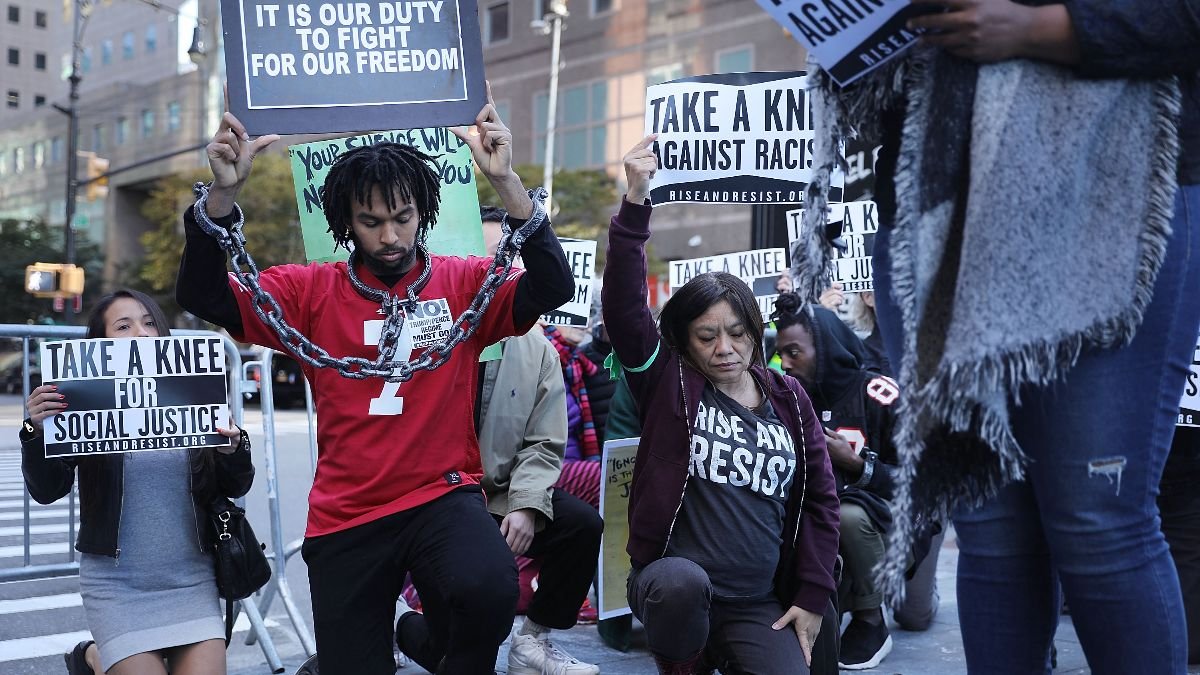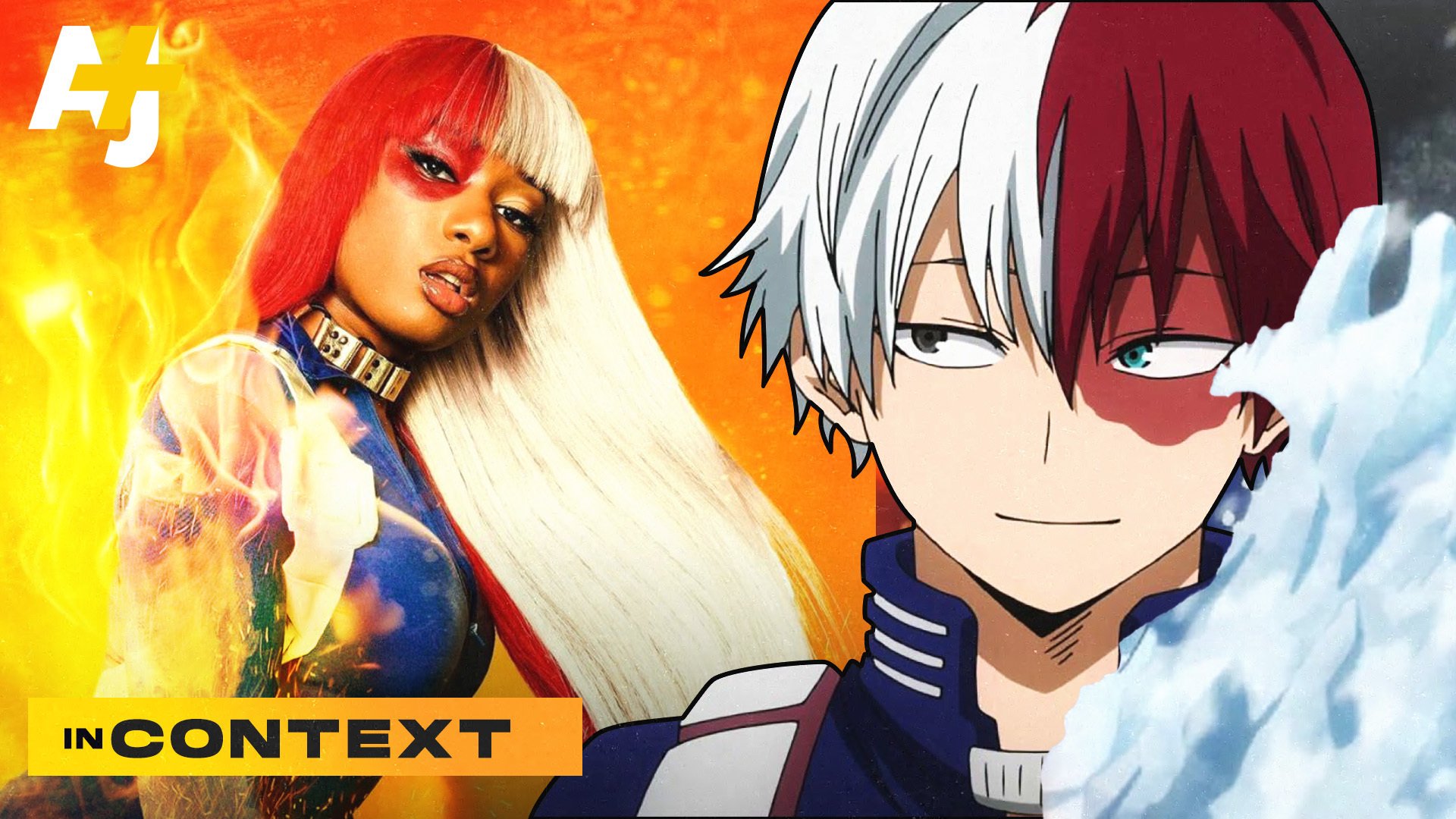Understanding ‘The Kaepernick Effect’
A coalition of advocacy groups 'take a knee' outside of a hotel where members of the quarterly NFL league meetings are being held on October 17, 2017 in New York City. [Spencer Platt / Getty Images via AFP]
Before protesters rallied against police brutality last summer, student athletes nationwide were bringing racial justice struggles to their communities.
For many of them, this also meant dealing with a brutal backlash.
In his recent book, sports writer Dave Zirin chronicles the impact that former San Francisco 49ers quarterback Colin Kaepernick had on student athletes across the country in 2016 when he decided to protest racial injustice by taking a knee during the national anthem.
The police murder of George Floyd last summer inspired some of the largest demonstrations in U.S. history, Zirin said, and “while many roads may have led us to that point, I believe that one of those roads runs straight through the athletic fields.”
Over Zoom, Zirin and I spoke about his book, and how student athletes continue to play an important role in the ongoing conversation about racism in the U.S. today. (This interview has been edited for length and clarity.)
What is the Kaepernick effect, exactly?
The Kaepernick effect is the chain reaction that took place after Colin Kaepernick first took a knee to protest racial inequity and police violence [during the national anthem] while playing for the San Francisco 49ers in August of 2016.
And the effect was, young people [started] using the anthem space to protest by taking a knee in cities and small towns all around the country. By doing so, they were able to start conversations in their communities about race and racism, and experienced one heck of a backlash.
[It] basically was a harbinger of a lot of the issues we're dealing with here in 2021.
When did you begin working on The Kaepernick Effect?
I started interviewing folks at the very beginning of the pandemic. I really did think that this part of history was going to be forgotten – we would remember this period as being just about Colin Kaepernick, and not about these amazing stories that were taking place all over the country.
I could have done a whole book with pro athletes, and done a massive section on college, but the reality is that the high school athletes have carried a lot of the weight.
When the demonstrations started in the summer of 2020, I went back and called everybody who I had spoken with, and they were all either in the streets, or organizing folks to get out into the streets. That's when it really clicked for me that this is also a story about the road that led us to [the protests of] 2020.
Obviously, if I had to turn in my manuscript today, I would also talk about some of the hysteria around so-called critical race theory, and the backlash that's taken place since last summer, and how these young people experienced that backlash in miniature … it really was a window into the future.
What are the parallels between these protests and the demonization of CRT?
In 2016, you see almost a federalized version of what is now a national backlash. The similarities are that these white parents feel like sports should be either a space that reflects their politics, or it should reflect what in their mind is “no politics.”
They saw these young people taking a knee during the anthem as imposing the politics of anti-racism [on] them, and they didn't want it anywhere near their children.
Fast forward to 2021, it’s this similar thing, where politicians and other various grifters are exploiting white people's fears. Similarly with sports, it was a feeling of a lack of control over what was being taught, except the teachers were 15-, 16-, 17-year-olds.
Why was it high schoolers who carried these protests?
I think high school athletes may have felt a little bit more freedom than college athletes, who was there on scholarship. There are just more high schoolers than people in college on teams, so the sheer numbers are much greater.
I also think this generation is uniquely poised to challenge bigotry, due to their demography, and the fact that they're less tolerant of intolerance. Their political lives have been defined by the war on terror, the pandemic and school shootings. So they were people who are ready to resist, and what Kaepernick did is [he] provided a language by which one could express their dissent while still being an athlete.
What was the opposition’s playbook for cracking down on the protests?
The playbook is always very strongly defined by whether or not you have a coach or adult authority figure who's willing to take the weight with the student.
Unfortunately, in the majority of the cases, [the coach] stepped away from the young person, and let them shoulder this on their own. The playbook becomes one of demonization and isolation.
What happened to the students who were demonized?
If it was a Black student on their own, the backlash, especially from a predominantly white community, was unforgiving. In cases where white people took part in the protests alongside their Black teammates, [this] tended to act like more of a shield and tamped down the public and administrative backlash. With women, a common link is online harassment after the fact.
The two big common threads were, first, that nobody felt like they shouldn't have done it – no matter what they had to suffer through, they felt like they were on the right side of history. The second is that there would be people out in the world and oftentimes in their community who [said], “I don't like what you're saying, therefore I am willing to commit violence against you.”
Everyone I spoke to, the name you heard more than Kaepernick's name was Trayvon Martin. It was striking to me how scarred people were by the murder of Martin in 2012. A lot of them were 10, 11, 12 years old when that happened, so it had a really lasting effect.
How did mainstream news coverage fail or help these students?
I think this has been covered very poorly. It's never looked at as a totality, always as a one-off event, even though these [demonstrations] were happening all over the country.
So there was no sense that these young folks were somehow influenced by forces beyond the San Francisco 49ers quarterback, either.
A lot of the coverage is just like, this is copycatting, or followers of a trend, which is so patronizing. Also, a lot of the people I spoke with said it was the first time they'd ever spoken to a journalist. That, to me, sort of gives the game away.
Have these protests changed the popular narrative that sports are apolitical?
Sports [have been] irrevocably changed in the last 5-10 years. No one would ever claim sports to be an apolitical space at this point, unless they were willingly closing their eyes and ears to what's taken place.
Papers like The Washington Post are adding more people to cover this particular beat of what they call “sports and culture.” What they're really saying is that sports can't be understood or confined to what happens inside the lines [on the field]. That's now the accepted truth.




